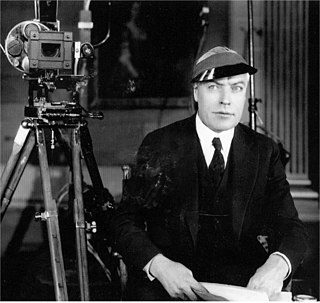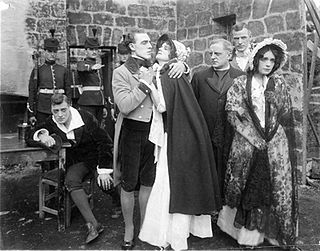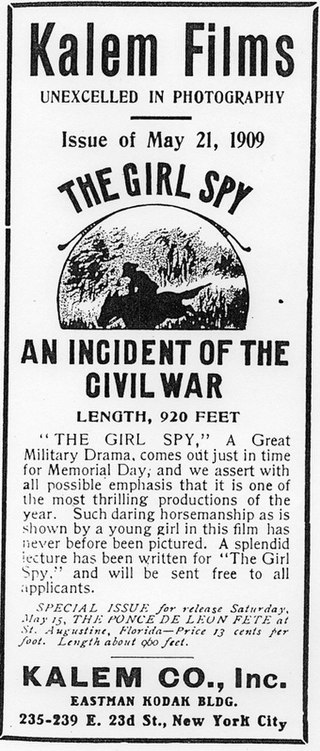The year 1907 in film involved some significant events.

Sidney Olcott was a Canadian-born film producer, director, actor and screenwriter.

Ben-Hur: A Tale of the Christ is a novel by Lew Wallace, published by Harper and Brothers on November 12, 1880, and considered "the most influential Christian book of the nineteenth century". It became a best-selling American novel, surpassing Harriet Beecher Stowe's Uncle Tom's Cabin (1852) in sales. The book also inspired other novels with biblical settings and was adapted for the stage and motion picture productions.

Ben-Hur: A Tale of the Christ is a 1925 American silent epic adventure-drama film directed by Fred Niblo and written by June Mathis based on the 1880 novel Ben-Hur: A Tale of the Christ by General Lew Wallace. Starring Ramon Novarro as the title character, the film is the first feature-length adaptation of the novel and second overall, following the 1907 short.

Ben-Hur is a 1959 American epic religious film directed by William Wyler, produced by Sam Zimbalist, and starring Charlton Heston as the title character. A remake of the 1925 silent film with a similar title, it was adapted from Lew Wallace's 1880 novel Ben-Hur: A Tale of the Christ. The screenplay is credited to Karl Tunberg, but includes contributions from Maxwell Anderson, S. N. Behrman, Gore Vidal, and Christopher Fry.

Gene Gauntier was an American screenwriter and actress who was one of the pioneers of the motion picture industry. A writer, director, and actress in films from mid 1906 to 1920, she wrote screenplays for 42 films. She performed in 87 films and is credited as the director of The Grandmother (1909).

The Kalem Company was an early American film studio founded in New York City in 1907. It was one of the first companies to make films abroad and to set up winter production facilities, first in Florida and then in California. Kalem was sold to Vitagraph Studios in 1917.

Frank Joseph Marion was an American motion picture pioneer. He was born in Tidioute, Pennsylvania. He had a wife named Florence and 4 daughters and a son. He was married to Florence until her death.

The Lad from Old Ireland, also called A Lad from Old Ireland, is a one-reel 1910 American motion picture directed by and starring Sidney Olcott and written by and co-starring Gene Gauntier. It was the first film appearance of prolific actor/director J.P. McGowan.
Film rights are rights under copyright law to produce a film as a derivative work of a given item of intellectual property. In US law, these rights belong to the holder of the copyright, who may sell them to someone in the film industry—usually a producer or director, or sometimes a specialist broker of such properties—who will then try to gather industry professionals and secure the financial backing necessary to convert the property into a film. Such rights differ from the right to commercially exhibit a finished motion picture, which rights are usually referred to as "exhibition rights" or "public-performance rights".

Jack J. Clark was an American director and actor of the early motion picture industry.

Ben-Hur was an 1899 theatrical adaptation of the novel Ben-Hur: A Tale of the Christ (1880) by Lew Wallace. The story was dramatized by William W. Young and produced by Marc Klaw and A. L. Erlanger. The stage production was notable for its elaborate use of spectacle, including live horses for the famous chariot race. The hippodrama had six acts with incidental music written by American composer Edgar Stillman Kelley. The stage production opened at the Broadway Theater in New York City on November 29, 1899, and became a hit Broadway show. Traveling versions of the production, including a national tour that ran for twenty-one years, played in the United States, Great Britain, and Australia. By the end of its run in April 1920, the play had been seen by more than twenty million people and earned over $10 million at the box office. There have been other stage adaptations of Wallace's novel, as well as several motion picture versions.

Ben-Hur is a 2016 epic historical drama film directed by Timur Bekmambetov and written by Keith Clarke and John Ridley. It is the fifth film adaptation of the 1880 novel Ben-Hur: A Tale of the Christ by Lew Wallace following the 1907 silent short film, the 1925 silent film, the Academy Award-winning 1959 film and the 2003 animated film; it is the third version produced by Metro-Goldwyn-Mayer. It has been termed a "re-adaptation", "reimagining", and "new interpretation" of the novel, and follows Judah Ben-Hur, a young prince who is falsely accused by his step-brother, an officer of the Roman army, and is sent to slavery, only to escape and seek vengeance. The film stars Jack Huston as the titular character, alongside Toby Kebbell, Rodrigo Santoro, Nazanin Boniadi, Ayelet Zurer, and Morgan Freeman. Principal photography began on February 2, 2015, in Matera, Italy and lasted about five months, finishing in June 2015.

The Shaughraun is a 1912 American silent film produced by Kalem Company and distributed by General Films Company. It was directed by Sidney Olcott with himself, Gene Gauntier, Alice Hollister and Jack J. Clark in the leading roles.
The Scarlet Letter is a lost 1908 silent American short film, directed by Sidney Olcott. It was based on the 1850 novel of the same name by Nathaniel Hawthorne. The screenplay was written by Gene Gauntier, who also played the character Hester Prynne. The film was produced by Kalem Company.

For Love of an Enemy is a one-reel 1911 American motion picture produced by Kalem Company and directed by Sidney Olcott. A war story detailing the adventures and the love affair of a Union spy in the Confederate lines.

The Girl Spy Before Vicksburg is a 1910 American silent film produced by Kalem Company of New York and shot at the company's "winter studio" in Jacksonville, Florida. Directed by Sidney Olcott, the Civil War drama stars Gene Gauntier, Robert Vignola and JP McGowan. Gauntier, in addition to performing as the production's title character, is credited with writing its storyline or "scenario".

Tangled Lives is a one-reel 1911 American motion picture produced by Kalem Company and directed by Sidney Olcott with Gene Gauntier, Jack J. Clark and JP McGowan in the leading roles. The action takes place during the Seminoles war, in Florida.
Kalem Co. v. Harper Bros., 222 U.S. 55 (1911), was a United States Supreme Court case in which the Court held producing a motion picture based on a dramatic work can be copyright infringement. The producer of the motion picture is liable even they are not the exhibitor. This does not extend to a restriction of the dramatic work's ideas; it is a recognition of the author's monopoly powers granted by Congress.

The Girl Spy: An Incident of the Civil War is a 1909 American silent film produced by Kalem Company and directed by Sidney Olcott with Gene Gauntier in the leading role. A story of the Civil War.




















